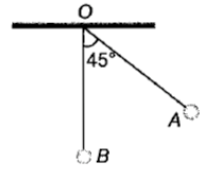A spring 40 mm long is stretched by the application of a force. If 10 N force required to stretch the spring through 1 mm, then work done in stretching the spring through 40 mm is
1. 84J
2. 68J
3. 23J
4. 8J
One projectile moving with velocity v in space, gets burst into 2 parts of masses in the ratio 1:3. The smaller part becomes stationary. What is the velocity of the other part?
1. 4v
2. v
3.
4.
A stationary bomb explodes into two parts of masses 3kg and 1kg. The total KE of the two parts after explosion is 2400 J. The KE of smaller part is
1. 600 J
2. 1800 J
3. 1200 J
4. 2160 J
A body at rest breaks into two pieces of equal masses. The parts will move
1. in same direction
2. along different lines
3. in opposite directions with equal speeds
4. in opposite directions with unequal speeds

1. \(250\sqrt{3}~\text{N to right}\)
2. \(250~\text{N to right}\)
3. \(250\sqrt{3}~\text{N to left}\)
4. \(250~\text{N to left}\)
Which of the following statements is correct?
1. Kinetic energy and momentum both are conserved in all types of collisions
2. Total kinetic energy is not conserved but momentum is conserved in inelastic COI-
lisions
3. Momentum is conserved In elastic collisions but .not in inelastic collisions
4. Total kinetic energy is conserved in inelastic collisions but momentum is not conserved in elastic collisions

1. \(-\frac{m}{2}v_0\hat j\)
2. \(-\frac{3}{4}mv_0\hat j\)
3. \(-\frac{5}{4}mv_0\hat i\)
4. None of these
A ball hits the floor and rebounds after an inelastic collision. In this case
1. the momentum of the ball just after the collision is the same as that just before the collision
2. the mechanical energy of the ball remains the same in the collision
3. the total momentum of the ball and the earth is conserved
4. the total energy of the ball and the earth is conserved
The bob A of a simple pendulum is released when the string makes an angle of 45 with the vertical. It hits another bob B of the same material and the same mass kept at rest on a table. If the collision is elastic


1. Both A and B rise to the same height
2. Both A and B come to rest at B
3. Both A and B move with the same velocity of A
4. A comes to rest and B moves with the velocity of A
If a body of mass m collides head on, elastically with velocity u with another identical body at rest. After collision velocity of the second body will be
1. zero
2. u
3. 2u
4. data insufficient


